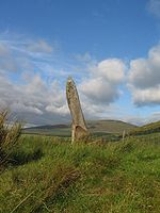
Macroom
Encyclopedia
Macroom is a market town
in Ireland
located in a valley on the River Sullane
, a tributary of the River Lee
, between Cork
and Killarney
. It is one of the key gateways to the tourist region of West Cork
. The town recorded a population on 3,553 in the 2006 national census. The name in Irish Gaelic
may mean 'meeting place of followers of the god Crom
or 'crooked plain', the latter derived from a large oak tree at one time growing in the town-square. Traditionally, it is said that Macroom is "the town that never reared a fool."
The area was once a meeting place for the Druid
s of Munster
, and its first mention in the records comes from the sixth century. The town was the site of a major battle involving Brian Boru
in the 10th century and in the following centuries suffered a series of invasions by warring families, including those by Murcheatach Uí Briain and Richard de Cogan. Finally the MacCarthy family took control of the area and led the town towards prosperity through such activities as milling, markets and fairs.
In 1650, Macroom became a centre point of conflict in the Cromwellian conquest of Ireland
. During the Irish War of Independence
in the early the 20th Century, the town was a centre of IRA
activity. During the late 19th century a number of Anglo-Irish
families were prominent in the town, however their estate-houses were burned out during the 1920s troubles, and after they fled their land was redistributed to the former tenants.
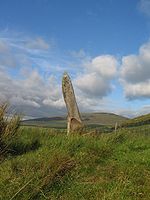 The legacy of Macroom's pre-Christian habitation survives in the many standing stones
The legacy of Macroom's pre-Christian habitation survives in the many standing stones
, dolmens, stone circle
s and fulacht fiadh
in the surrounding land. The area was a pre-Christian centre for Bardic conventions and acted as a base for the Druid
s of Munster. The first recorded historical reference to the town dates to the sixth century when the townland was known as Achad Dorbchon, and held within the kingdom of Muscraighe Mitine. The dominant clan within the province of Munster
at this time was the Eóganachta
dynasty; they held kingdoms from Muscraighe Mitine to the midlands town of Birr
. The tribe of Uí Floinn was most prominent local clan, and at some time in their reign a castle was built in Achad Dorbchon to replace Raithleann as the capital of Muskerry.
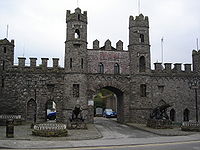 Muscraighe Mitine underwent three invasions during the thirteenth century; from the Murcheatach Uí Briain and Richard de Cogan in 1201 and 1207 respectively, and finally from the MacCarthy family who had become the dominant and most powerful family in what was then known as Muscraighe Uí Fhloinn. The MacCarthy family occupied the castle from this time up until the middle of the seventeenth century. By the fourteenth century Achad Dorbchon was accepted to be the capital of the Barony of Muskerry, and was seen as a growing centre for trade, burial and religious worship.
Muscraighe Mitine underwent three invasions during the thirteenth century; from the Murcheatach Uí Briain and Richard de Cogan in 1201 and 1207 respectively, and finally from the MacCarthy family who had become the dominant and most powerful family in what was then known as Muscraighe Uí Fhloinn. The MacCarthy family occupied the castle from this time up until the middle of the seventeenth century. By the fourteenth century Achad Dorbchon was accepted to be the capital of the Barony of Muskerry, and was seen as a growing centre for trade, burial and religious worship.
Macroom was one of the earliest centres in Ireland where milling was carried out. From the end of the sixteenth century the town began to grow from a village settlement to a functionally diverse urban centre. The locality grew outwards from the castle. The MacCarthys established the town as a centre for markets and fairs, and in 1620 a market house was built to the east of and facing the castle. The family introduced a plantation
scheme which aimed to attract new agriculture and industrial techniques and methods to the area. By the mid-seventeenth century English families owned approximately one-third of the town in value terms. The Protestant families introduced butter making to the town; an industry that was labour intensive and had a positive effect on local dairy farming.
The battle of Macroom
took place near the town in 1650, during the Cromwellian conquest of Ireland
. Bishop Boetius McEgan, fighting on behalf of the MacCarthys failed to hold the Castle, and he was taken prisoner by the Cromwellian forces and hanged at Carrigadrohid
.
A 1750 tenement
list shows the town at that time to comprised 134 buildings and 300 families, with a population ratio of 6 to 1 between Catholic and Protestants. By now the town had developed from a locality of mud cabins in the early 1660s to a linear shaped urban settlement consisting mainly of thatched cabins, replaced in due course by solid cottages through efforts of the Irish Land and Labour Association
(ILLA) founded in 1894.
Macroom was the birth-place of Admiral Sir William Penn, a distinguished British Admiral and father of William Penn
, after whom the state of Pennsylvania
is named. Penn spent a deal of time in his father's birth-place, particularly during his childhood. The remains of their castle can still be seen today.
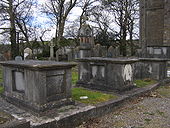 During the Irish War of Independence
During the Irish War of Independence
(1919–1921), Macroom was the base in Cork for the British Auxiliary Division
. At the Kilmichael Ambush
in 1920, 17 Auxiliaries were killed on the road between Macroom and Dunmanway by the local Irish Republican Army
under Tom Barry
. In May 1922, between the signing of the Anglo-Irish Treaty
and the Irish Civil War
, 4 British soldiers were kidnapped and executed. Macroom castle was burned out on five separate occasions; the last occasion was on 18 August 1922 following the evacuation of British Auxiliaries from the town. The anti-treaty forces, including Erskine Childers
and Frank O'Connor
, had retreated from Cork City to Macroom. They burned the castle before retreating west. Michael Collins
was killed in 1922 in an ambush near Béal na mBláth
.
In 1924 the Castle and estate was gifted to the town by Lady Ardilaun, a descendant of the McCarthy chiefs, who was the widow of Lord Ardilaun
.
river channels. The area is thought to have been wooded since the end of the last Ice Age (c. 10,000 years ago). The alluvial woodland had extended as far as the Lee Bridge, however in 1954 the Lee hydro-electric
scheme was undertaken which led to extensive tree-felling and flooding in the area. The scheme resulted in the loss of sixty per-cent of the former oak woodland. Today, the Gearagh is of great natural importance due to its rich and rare diversity of wildlife, and represents the only extant extensive alluvial
woodland in Western Europe.
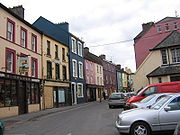 Tourist attractions include a colourful town centre, an 18-hole golf course and scenic surroundings. A few kilometres to the north of Macroom is Mushera Mountain, with the family attraction of Millstreet Country Park, a 1.5 km walk to the summit of the mountain, and the ancient Saint John's Well. Also The Castle Grounds located in the town is a popular place for tourists and includes fishing and golfing facilities.
Tourist attractions include a colourful town centre, an 18-hole golf course and scenic surroundings. A few kilometres to the north of Macroom is Mushera Mountain, with the family attraction of Millstreet Country Park, a 1.5 km walk to the summit of the mountain, and the ancient Saint John's Well. Also The Castle Grounds located in the town is a popular place for tourists and includes fishing and golfing facilities.
There are many holy wells, churches and other sites in the area associated with ancient visionaries and healers. 6 km west lies the historic Carrigaphooca Castle
. In the town itself, the Castle Arch, a remainder of the demolished Macroom Castle, admits walkers to the Castle demesne
parklands, held in trust as a gift to, and possession of, the people of Macroom. This large park contains riverside walks among mature oak
and beech
trees. It is very popular amongst mushroom enthusiasts.
The Convent of Mercy Secondary School is contained within the Sisters of Mercy
's complex attached to St. Colmans church, which also included a convent, a primary school, a graveyard and a grotto. Coláiste De La Salle was opened in 1933 and originally located in the town hall, until a permanent building was completed three years later. By the late 1970s the school was experiencing sever capacity issues and a re-structure and extension of the school was undertaken in 1982. Since its opening the ratio of pupils has remained relatively stable with 40% from coming the town and the rest from surrounding parishes. A new building was built in 2008 for St Colmans Boys National School after years of planning applications and appeals.
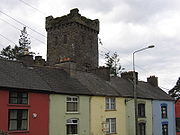 Macroom is situated on the national primary route N22, approximately 38 km from Cork city and 48 km from Killarney. There is an hourly bus service to and from Cork city. Macroom's nearest airport is Cork Airport. Between 1866 and 1953, a railway ran between the town and Cork city, terminating in the mart grounds. In 1890 there were five services each way on week days and two on Sundays, and the running time was just over an hour. Macroom railway station opened on 12 May 1866, closed for passenger traffic on 1 July 1935, closed for goods traffic on 10 March 1947 and finally closed altogether on 1 December 1953.
Macroom is situated on the national primary route N22, approximately 38 km from Cork city and 48 km from Killarney. There is an hourly bus service to and from Cork city. Macroom's nearest airport is Cork Airport. Between 1866 and 1953, a railway ran between the town and Cork city, terminating in the mart grounds. In 1890 there were five services each way on week days and two on Sundays, and the running time was just over an hour. Macroom railway station opened on 12 May 1866, closed for passenger traffic on 1 July 1935, closed for goods traffic on 10 March 1947 and finally closed altogether on 1 December 1953.
Market town
Market town or market right is a legal term, originating in the medieval period, for a European settlement that has the right to host markets, distinguishing it from a village and city...
in Ireland
Ireland
Ireland is an island to the northwest of continental Europe. It is the third-largest island in Europe and the twentieth-largest island on Earth...
located in a valley on the River Sullane
River Sullane
The River Sullane runs from the mountains between County Cork and County Kerry in southern Ireland. It runs through the centre of Macroom, to which it provides drinking water , joins the River Launa one kilometre east of the town, before joining the River Lee a further kilometre east...
, a tributary of the River Lee
River Lee (Ireland)
The Lee is a river in Ireland. It rises in the Shehy Mountains on the western border of County Cork and flows eastwards through Cork City, where it splits in two for a short distance, creating an island on which Cork's city centre is built, and empties into the Celtic Sea at Cork Harbour on the...
, between Cork
Cork (city)
Cork is the second largest city in the Republic of Ireland and the island of Ireland's third most populous city. It is the principal city and administrative centre of County Cork and the largest city in the province of Munster. Cork has a population of 119,418, while the addition of the suburban...
and Killarney
Killarney
Killarney is a town in County Kerry, southwestern Ireland. The town is located north of the MacGillicuddy Reeks, on the northeastern shore of the Lough Lein/Leane which are part of Killarney National Park. The town and its surrounding region are home to St...
. It is one of the key gateways to the tourist region of West Cork
West Cork
West Cork refers to a geographical area in south-west Ireland, lying within Ireland's largest county, County Cork. Traditionally a popular tourist destination, the area is seen as being distinct from the more populated northern or eastern parts of the county, as well as the more urban area of...
. The town recorded a population on 3,553 in the 2006 national census. The name in Irish Gaelic
Irish language
Irish , also known as Irish Gaelic, is a Goidelic language of the Indo-European language family, originating in Ireland and historically spoken by the Irish people. Irish is now spoken as a first language by a minority of Irish people, as well as being a second language of a larger proportion of...
may mean 'meeting place of followers of the god Crom
Crom Cruach
Crom Cruach or Cromm Crúaich , also known as Cenn Cruach /ˈkʲɛnˠ: ˈkɾˠuəxˠ/ or Cenncroithi /ˈkʲɛnˠ: ˈkɾˠoθʲɨ/, was a deity in pre-Christian Ireland, reputedly propitiated with human sacrifice, whose worship is said to have been ended by St...
or 'crooked plain', the latter derived from a large oak tree at one time growing in the town-square. Traditionally, it is said that Macroom is "the town that never reared a fool."
The area was once a meeting place for the Druid
Druid
A druid was a member of the priestly class in Britain, Ireland, and Gaul, and possibly other parts of Celtic western Europe, during the Iron Age....
s of Munster
Munster
Munster is one of the Provinces of Ireland situated in the south of Ireland. In Ancient Ireland, it was one of the fifths ruled by a "king of over-kings" . Following the Norman invasion of Ireland, the ancient kingdoms were shired into a number of counties for administrative and judicial purposes...
, and its first mention in the records comes from the sixth century. The town was the site of a major battle involving Brian Boru
Brian Boru
Brian Bóruma mac Cennétig, , , was an Irish king who ended the domination of the High Kingship of Ireland by the Uí Néill. Building on the achievements of his father, Cennétig mac Lorcain, and especially his elder brother, Mathgamain, Brian first made himself King of Munster, then subjugated...
in the 10th century and in the following centuries suffered a series of invasions by warring families, including those by Murcheatach Uí Briain and Richard de Cogan. Finally the MacCarthy family took control of the area and led the town towards prosperity through such activities as milling, markets and fairs.
In 1650, Macroom became a centre point of conflict in the Cromwellian conquest of Ireland
Cromwellian conquest of Ireland
The Cromwellian conquest of Ireland refers to the conquest of Ireland by the forces of the English Parliament, led by Oliver Cromwell during the Wars of the Three Kingdoms. Cromwell landed in Ireland with his New Model Army on behalf of England's Rump Parliament in 1649...
. During the Irish War of Independence
Irish War of Independence
The Irish War of Independence , Anglo-Irish War, Black and Tan War, or Tan War was a guerrilla war mounted by the Irish Republican Army against the British government and its forces in Ireland. It began in January 1919, following the Irish Republic's declaration of independence. Both sides agreed...
in the early the 20th Century, the town was a centre of IRA
Irish Republican Army
The Irish Republican Army was an Irish republican revolutionary military organisation. It was descended from the Irish Volunteers, an organisation established on 25 November 1913 that staged the Easter Rising in April 1916...
activity. During the late 19th century a number of Anglo-Irish
Anglo-Irish
Anglo-Irish was a term used primarily in the 19th and early 20th centuries to identify a privileged social class in Ireland, whose members were the descendants and successors of the Protestant Ascendancy, mostly belonging to the Church of Ireland, which was the established church of Ireland until...
families were prominent in the town, however their estate-houses were burned out during the 1920s troubles, and after they fled their land was redistributed to the former tenants.
History

Glantane east
Glantane East is a megalithic complex situated from Millstreet, County Cork, Ireland. It is set in the Keel River valley on the north-west upper slopes of Musherabeg mountain, in the townland of Glantane...
, dolmens, stone circle
Carrigagulla
Carrigagulla is a megalithic complex located 2.9 km north-east of Ballinagree, County Cork, Ireland. It comprises two recumbent stone circles, two stone rows, and an ogham stone which has been moved around a half mile away....
s and fulacht fiadh
Fulacht fiadh
A fulacht fiadh is a type of archaeological site found in Ireland. In England, Scotland, Wales and the Isle of Man they are known as burnt mounds. They commonly survive as a low horseshoe-shaped mound of charcoal-enriched soil and heat shattered stone with a slight depression at its centre showing...
in the surrounding land. The area was a pre-Christian centre for Bardic conventions and acted as a base for the Druid
Druid
A druid was a member of the priestly class in Britain, Ireland, and Gaul, and possibly other parts of Celtic western Europe, during the Iron Age....
s of Munster. The first recorded historical reference to the town dates to the sixth century when the townland was known as Achad Dorbchon, and held within the kingdom of Muscraighe Mitine. The dominant clan within the province of Munster
Munster
Munster is one of the Provinces of Ireland situated in the south of Ireland. In Ancient Ireland, it was one of the fifths ruled by a "king of over-kings" . Following the Norman invasion of Ireland, the ancient kingdoms were shired into a number of counties for administrative and judicial purposes...
at this time was the Eóganachta
Eóganachta
The Eóganachta or Eoghanachta were an Irish dynasty centred around Cashel which dominated southern Ireland from the 6/7th to the 10th centuries, and following that, in a restricted form, the Kingdom of Desmond, and its offshoot Carbery, well into the 16th century...
dynasty; they held kingdoms from Muscraighe Mitine to the midlands town of Birr
Birr
Birr is a town in County Offaly, Ireland. Once called Parsonstown, after the Parsons family who were local landowners and hereditary Earls of Rosse. It is also a parish in the Roman Catholic Diocese of Killaloe....
. The tribe of Uí Floinn was most prominent local clan, and at some time in their reign a castle was built in Achad Dorbchon to replace Raithleann as the capital of Muskerry.

Macroom was one of the earliest centres in Ireland where milling was carried out. From the end of the sixteenth century the town began to grow from a village settlement to a functionally diverse urban centre. The locality grew outwards from the castle. The MacCarthys established the town as a centre for markets and fairs, and in 1620 a market house was built to the east of and facing the castle. The family introduced a plantation
Plantation (settlement or colony)
Plantation was an early method of colonization in which settlers were "planted" abroad in order to establish a permanent or semi-permanent colonial base. Such plantations were also frequently intended to promote Western culture and Christianity among nearby indigenous peoples, as can be seen in the...
scheme which aimed to attract new agriculture and industrial techniques and methods to the area. By the mid-seventeenth century English families owned approximately one-third of the town in value terms. The Protestant families introduced butter making to the town; an industry that was labour intensive and had a positive effect on local dairy farming.
The battle of Macroom
Battle of Macroom
The Battle of Macroom was fought in 1650, near Macroom, County Cork, in southern Ireland, during the Cromwellian conquest of Ireland. An English Parliamentarian force under Roger Boyle, 1st Earl of Orrery defeated an Irish Confederate force under David Roche....
took place near the town in 1650, during the Cromwellian conquest of Ireland
Cromwellian conquest of Ireland
The Cromwellian conquest of Ireland refers to the conquest of Ireland by the forces of the English Parliament, led by Oliver Cromwell during the Wars of the Three Kingdoms. Cromwell landed in Ireland with his New Model Army on behalf of England's Rump Parliament in 1649...
. Bishop Boetius McEgan, fighting on behalf of the MacCarthys failed to hold the Castle, and he was taken prisoner by the Cromwellian forces and hanged at Carrigadrohid
Carrigadrohid
Carrigadrohid: is a village in the Canovee Electoral Area of Mid-Cork, Ireland, situated on the north bank of the River Lee...
.
A 1750 tenement
Tenement
A tenement is, in most English-speaking areas, a substandard multi-family dwelling, usually old, occupied by the poor.-History:Originally the term tenement referred to tenancy and therefore to any rented accommodation...
list shows the town at that time to comprised 134 buildings and 300 families, with a population ratio of 6 to 1 between Catholic and Protestants. By now the town had developed from a locality of mud cabins in the early 1660s to a linear shaped urban settlement consisting mainly of thatched cabins, replaced in due course by solid cottages through efforts of the Irish Land and Labour Association
Irish Land and Labour Association
The Irish Land and Labour Association was a progressive movement founded in the early 1890s in Munster, Ireland, to organise and pursue political agitation for small tenant farmers' and rural labourers' rights. Its branches also spread into Connacht. The ILLA was known under different names—Land...
(ILLA) founded in 1894.
Macroom was the birth-place of Admiral Sir William Penn, a distinguished British Admiral and father of William Penn
William Penn
William Penn was an English real estate entrepreneur, philosopher, and founder of the Province of Pennsylvania, the English North American colony and the future Commonwealth of Pennsylvania. He was an early champion of democracy and religious freedom, notable for his good relations and successful...
, after whom the state of Pennsylvania
Pennsylvania
The Commonwealth of Pennsylvania is a U.S. state that is located in the Northeastern and Mid-Atlantic regions of the United States. The state borders Delaware and Maryland to the south, West Virginia to the southwest, Ohio to the west, New York and Ontario, Canada, to the north, and New Jersey to...
is named. Penn spent a deal of time in his father's birth-place, particularly during his childhood. The remains of their castle can still be seen today.

Irish War of Independence
The Irish War of Independence , Anglo-Irish War, Black and Tan War, or Tan War was a guerrilla war mounted by the Irish Republican Army against the British government and its forces in Ireland. It began in January 1919, following the Irish Republic's declaration of independence. Both sides agreed...
(1919–1921), Macroom was the base in Cork for the British Auxiliary Division
Auxiliary Division
The Auxiliary Division of the Royal Irish Constabulary , generally known as the Auxiliaries or Auxies, was a paramilitary organization within the Royal Irish Constabulary during the Irish War of Independence....
. At the Kilmichael Ambush
Kilmichael Ambush
The Kilmichael Ambush was an ambush near the village of Kilmichael in County Cork on 28 November 1920 carried out by the Irish Republican Army during the Irish War of Independence. Thirty-six local IRA volunteers commanded by Tom Barry killed seventeen members of the RIC Auxiliary Division...
in 1920, 17 Auxiliaries were killed on the road between Macroom and Dunmanway by the local Irish Republican Army
Irish Republican Army
The Irish Republican Army was an Irish republican revolutionary military organisation. It was descended from the Irish Volunteers, an organisation established on 25 November 1913 that staged the Easter Rising in April 1916...
under Tom Barry
Tom Barry
Thomas Barry was one of the most prominent guerrilla leaders in the Irish Republican Army during the Irish War of Independence.-Early life:...
. In May 1922, between the signing of the Anglo-Irish Treaty
Anglo-Irish Treaty
The Anglo-Irish Treaty , officially called the Articles of Agreement for a Treaty Between Great Britain and Ireland, was a treaty between the Government of the United Kingdom of Great Britain and Ireland and representatives of the secessionist Irish Republic that concluded the Irish War of...
and the Irish Civil War
Irish Civil War
The Irish Civil War was a conflict that accompanied the establishment of the Irish Free State as an entity independent from the United Kingdom within the British Empire....
, 4 British soldiers were kidnapped and executed. Macroom castle was burned out on five separate occasions; the last occasion was on 18 August 1922 following the evacuation of British Auxiliaries from the town. The anti-treaty forces, including Erskine Childers
Robert Erskine Childers
Robert Erskine Childers DSC , universally known as Erskine Childers, was the author of the influential novel Riddle of the Sands and an Irish nationalist who smuggled guns to Ireland in his sailing yacht Asgard. He was executed by the authorities of the nascent Irish Free State during the Irish...
and Frank O'Connor
Frank O'Connor
Frank O’Connor was an Irish author of over 150 works, best known for his short stories and memoirs.-Early life:...
, had retreated from Cork City to Macroom. They burned the castle before retreating west. Michael Collins
Michael Collins (Irish leader)
Michael "Mick" Collins was an Irish revolutionary leader, Minister for Finance and Teachta Dála for Cork South in the First Dáil of 1919, Director of Intelligence for the IRA, and member of the Irish delegation during the Anglo-Irish Treaty negotiations. Subsequently, he was both Chairman of the...
was killed in 1922 in an ambush near Béal na mBláth
Béal na mBláth
Béal na mBláth, officially Béal Átha na Bláiche , is a small village in County Cork, Ireland. Both Bláth or Bláiche are variations of the word bláthach, meaning literally "flowery" or "floral", or in this case "buttermilk"....
.
In 1924 the Castle and estate was gifted to the town by Lady Ardilaun, a descendant of the McCarthy chiefs, who was the widow of Lord Ardilaun
Arthur Guinness, 1st Baron Ardilaun
Arthur Edward Guinness, 1st Baron Ardilaun, 2nd Baronet , known as Sir Arthur Guinness, Bt, between 1868 and 1880, was an Irish businessman, politician, and philanthropist, best known for giving St Stephen's Green to the people of Dublin.-Background and education:Guinness was born at St Anne's,...
.
Geography
1.5 km south of Macroom is the Gearagh, a national nature reserve which comprises an inland delta, made up of a series of small islands, separated by anastomosingAnastomosis
An anastomosis is the reconnection of two streams that previously branched out, such as blood vessels or leaf veins. The term is used in medicine, biology, mycology and geology....
river channels. The area is thought to have been wooded since the end of the last Ice Age (c. 10,000 years ago). The alluvial woodland had extended as far as the Lee Bridge, however in 1954 the Lee hydro-electric
Hydroelectricity
Hydroelectricity is the term referring to electricity generated by hydropower; the production of electrical power through the use of the gravitational force of falling or flowing water. It is the most widely used form of renewable energy...
scheme was undertaken which led to extensive tree-felling and flooding in the area. The scheme resulted in the loss of sixty per-cent of the former oak woodland. Today, the Gearagh is of great natural importance due to its rich and rare diversity of wildlife, and represents the only extant extensive alluvial
Alluvium
Alluvium is loose, unconsolidated soil or sediments, eroded, deposited, and reshaped by water in some form in a non-marine setting. Alluvium is typically made up of a variety of materials, including fine particles of silt and clay and larger particles of sand and gravel...
woodland in Western Europe.
Tourism

There are many holy wells, churches and other sites in the area associated with ancient visionaries and healers. 6 km west lies the historic Carrigaphooca Castle
Carrigaphooca Castle
Carrigaphooca Castle , meaning Castle on the Rock of the Fairy; the word Púca translates as kind of ghost or fairy) is a ruined five storey rectangular tower house, situated on a steep-sided rock, located 6 km west of Macroom, County Cork, Ireland. Although named as a castle, the Carrigaphooca...
. In the town itself, the Castle Arch, a remainder of the demolished Macroom Castle, admits walkers to the Castle demesne
Demesne
In the feudal system the demesne was all the land, not necessarily all contiguous to the manor house, which was retained by a lord of the manor for his own use and support, under his own management, as distinguished from land sub-enfeoffed by him to others as sub-tenants...
parklands, held in trust as a gift to, and possession of, the people of Macroom. This large park contains riverside walks among mature oak
Oak
An oak is a tree or shrub in the genus Quercus , of which about 600 species exist. "Oak" may also appear in the names of species in related genera, notably Lithocarpus...
and beech
Beech
Beech is a genus of ten species of deciduous trees in the family Fagaceae, native to temperate Europe, Asia and North America.-Habit:...
trees. It is very popular amongst mushroom enthusiasts.
Education
The town has two primary schools and three secondary schools; a De La Salle for boys, St. Mary's Secondary School Convent of Mercy for girls, and McEgan College, a mixed technical college located in the castle grounds.The Convent of Mercy Secondary School is contained within the Sisters of Mercy
Sisters of Mercy
The Religious Order of the Sisters of Mercy is an order of Catholic women founded by Catherine McAuley in Dublin, Ireland, in 1831. , the order has about 10,000 members worldwide, organized into a number of independent congregations....
's complex attached to St. Colmans church, which also included a convent, a primary school, a graveyard and a grotto. Coláiste De La Salle was opened in 1933 and originally located in the town hall, until a permanent building was completed three years later. By the late 1970s the school was experiencing sever capacity issues and a re-structure and extension of the school was undertaken in 1982. Since its opening the ratio of pupils has remained relatively stable with 40% from coming the town and the rest from surrounding parishes. A new building was built in 2008 for St Colmans Boys National School after years of planning applications and appeals.
Transport

Sources
- Hart, Peter M. The I.R.A. and Its Enemies: Violence and Community in Cork, 1916-1923. Oxford: Clarendon Press, 1999
- Ring, Denis Paul. A Historical Geography of Macroom C.500-1995. Castle House Publications, 1995.

